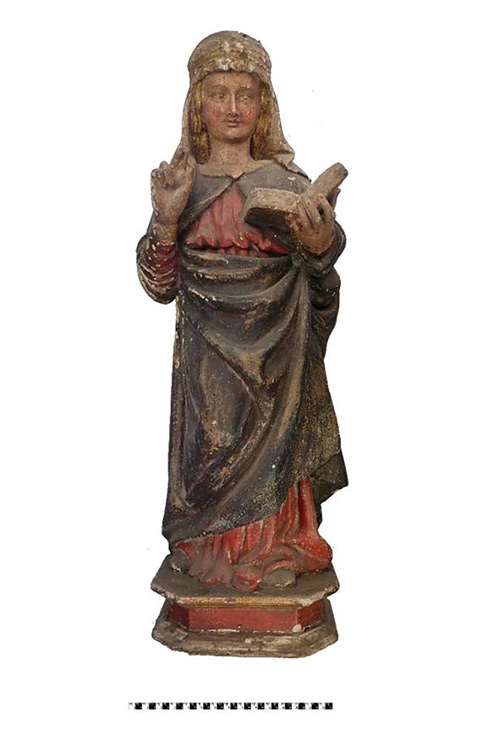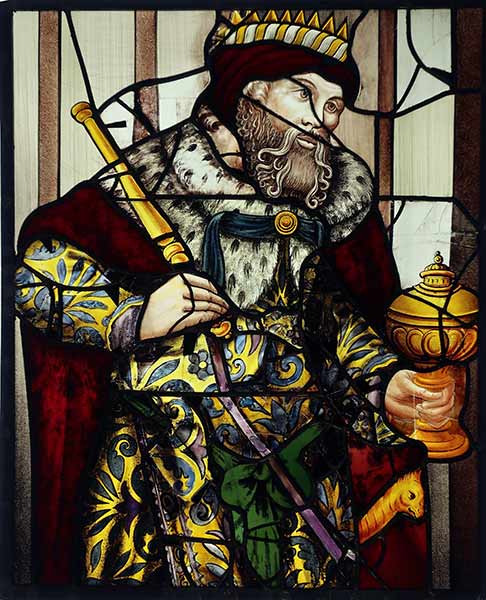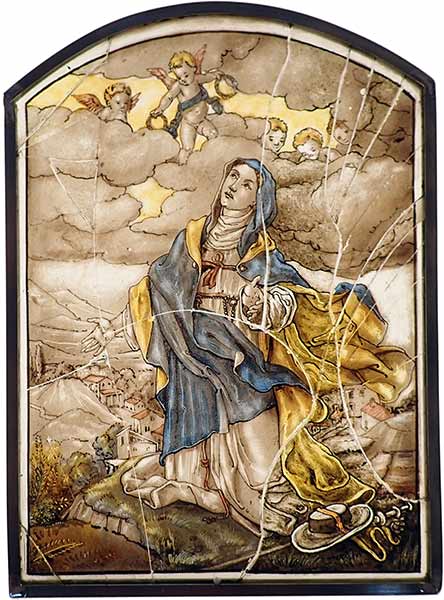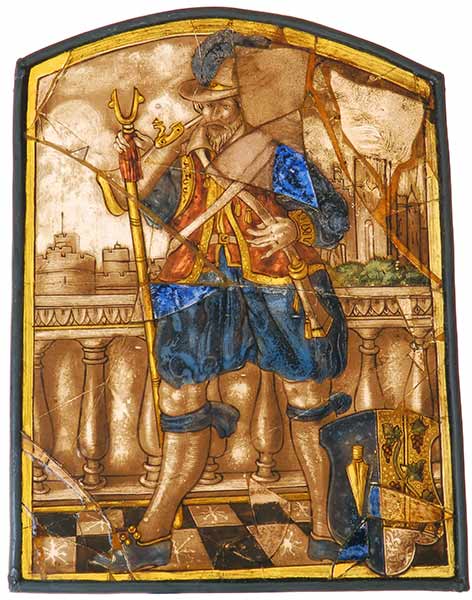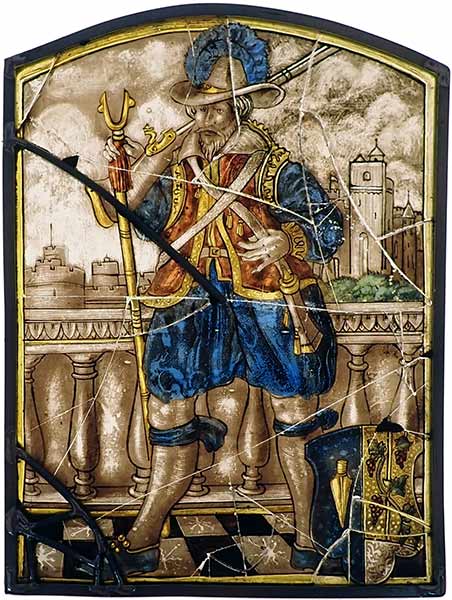Artefact Conservation
Changing environmental conditions impact on artefacts in the Abbey Museum collection. Objects made from metal, pottery, paper, fabrics, painted objects and wood being some of the most vulnerable. Abbey Museum staff annually review the most vulnerable in the collection to asses conservation requirements.
Current Fundraiser
Late Medieval Painted statue of a Saint (W01231)
This figure is a rare late medieval polychrome wood sculpture.
It depicts a female saint, standing on a hexagonal pedestal, and holding an open book in one hand and the other hand raised in blessing. She wears a red robe with dark blue overdress, a white veil secured by a gold circlet and slippers.
She possibly represents St Ann, the mother of the Virgin Mary. However, there are a number of female saints, such as St Barbara, who carry a book as one of their attributes or she could also be a little known local saint. Then again, the colour of her clothing is often associated with the Virgin Mary. It is possible this figure was originally from a group depicting Mary teaching the young Christ child.
The figure is wood with painted garments and gilt details. It is very rare to retain original paint on medieval sculptures. It is thought to be Central European (Austria or Germany) and possibly 16th century or earlier in date.
This object is in need of urgent conservation. There are structural concerns with major splits down the back of the figure that appear to have deepened since it was photographed in the early 1980s. Major paint loss has occurred on one side and on the robe over the arm; the veil and book. We are seeking to raise $5000 to undertake this conservation project.
Your support of the Abbey Museum’s Conservation Program would enable us to conserve this wonderful object for future generations to enjoy.
%
GOAL $5,000
Undergoing Conservation
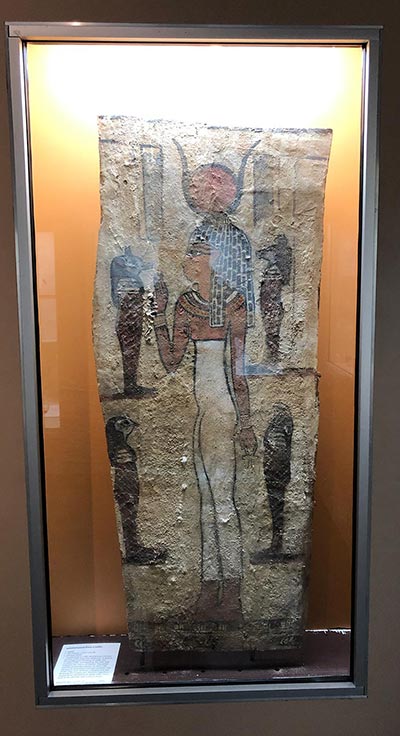
Egyptian Coffin Painted Panel
After successful fundraising efforts, this Ancient Egyptian painted panel from a coffin is currently in conservation! It is from the Late Period dating c 1075 – 332 BC and depicts the goddess Isis holding an ankh and wearing the solar disk between the horns of Hathor. The jackal and falcon-headed deities painted on either side represent two of the four sons of Horus who were charged with the keeping of the Canopic jars.
We are grateful for your support of the Abbey Museum’s Conservation Program!
%
GOAL $3,500
Completed Conservation Projects
Panel depicting Balthazar, from an Adoration of the Magi
North European, probably German or Flemish/Netherlandish
Uncertain; perhaps early 17th century.
H720 mm x W590 mm. Coloured glass, clear glass, vitreous paint and yellow stain
Formerly known as the ‘Donor King’, Ward identified this panel as one of the Magi wearing a falchion (a medieval cutlass). New research has now clearly identified the royal figure as Balthazar, one of the kings or wise men from an Adoration of the Magi window.
A masterpiece by the Netherlandish artist, Hieronymus Bosch, the Adoration of the Magi, is now in the Metropolitan Museum of Art, New York. In this work, dated c.1470-80, Balthazar is shown as a Negro with a golden crown. He wears a remarkable sword with a strange dragon hilt, and a sword with an almost identical hilt is depicted in W01469. The sword is suspended by a green sash, another of Balthazar’s attributes, and this is also prominent in the Abbey Museum’s window. This helps date the panel and also indirectly links it to Hieronymus Bosch. The maker of the glass may have seen the Adoration, as the sword type is extremely unusual.
Conservation
The window was removed in 2018 for conservation by Cummins and Stehn, Eumundi. Due to the poor condition of the leads, it was dismantled. It required extensive restoration because of the loss of glass. Acrylic infills and unsightly calmes were removed and fragments edge-glued together where possible using Hxtal NYL-1 conservation epoxy. Part of the garment, face hand, sceptre and panelling required repainting. The sceptre terminal was left plain as no reference could be found at the time. The panel was re-leaded and re-installed in its original location in July 2018.
Conservation funded by the Abbey Museum Friends in 2018.
Total Conservation – $6,750.00
Panel depicting a female saint
North European, probably German or Swiss
17th or 18th century AD
Conservation
The small panel of a female saint, identified by John Ward as St Rosalia, was badly damaged in transit from England to Australia. It was initially repaired at the University of Canberra in 1991 using conservation techniques that have been superseded and glues that are no longer considered acceptable.
In 2019 it was conserved by Gerry Cummins and Jill Stehn of Eumundi Conservation Studio. It was dismantled and cleaned; unsightly calmes and perspex infills from the 1991 restoration were removed. The removal of the epoxy glue was particularly challenging; the ancient glass was paper-thin and enormous care had to be taken to ensure the glass was not damaged further.
It was not the only challenge facing our conservators. Matching the colours of the glass paint used could be a headache. To quote Cummins and Stehn, “It’s now time to take the plunge and start applying the stains and enamels with our fingers crossed. Of course we will fire on the same tray, in the same kiln and at the same temperature as our test samples, but that’s no guarantee that they will come out the same colours as our samples. The original firings would also have had variations – stains coming out more lemon or more orange than anticipated, the blues more cobalt or Prussian than intended and the red more scarlet or crimson. That didn’t matter to them! It’s trying to match what was happening then that’s so important to us.”
Despite these challenges our dedicated conservators returned the completed panel to the Abbey Museum on 7th March 2019.
Conservation was funded by the Abbey Museum Friends in 2019 – $3,500.
Panel depicting a Musketeer with the Arms of Gemmingen-Adersbach
North European, probably German or Swiss
17th century AD
Conservation
The panel of the Musketeer was badly damaged in transit from England to Australia. It was repaired at the University of Canberra in 1991. In 2019 it was conserved by Gerry Cummins and Jill Stehn of Eumundi Conservation Studio. It was dismantled and cleaned, unsightly calmes removed and fragments edge-glued using Hxtal NYL-1 conservation epoxy. New pieces were painted to replace missing parts behind the head and shoulder, and above the tower.
The image of the Musketeer cuts a very dashing figure in his voluminous blue britches and plumed hat, standing on a balustrade with a castle rearing up behind him. When investigating how the original stained glass makers made the bright blue glass, Gerry Cummins noted, “something went wrong with their firing of the Musketeer’s blue enamel, which seems to have dissolved the un-fired under layer of brown paint and blended the two together, which is impossible to reproduce.”
Despite these challenges our dedicated conservators returned the completed panel to the Abbey Museum on 7th March 2019.
Conservation was funded by the Abbey Museum Friends in 2019 – $3,500.


